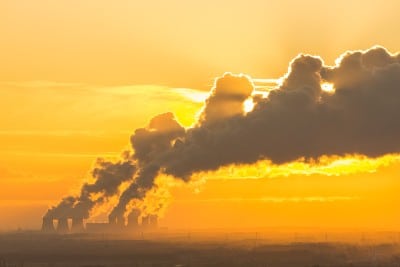Our Climate Crisis

This year was the hottest February on record. Global ocean temperatures in February were also at an all-time high for any time of year. Taken together, the past 12 months have been the hottest 12 consecutive months on record. Researchers say that our weirdly warm winter has the fingerprints of climate change all over it.
Methane emissions from the fossil-fuel industry rose to near-record levels last year, despite technology available to curb this pollution at virtually no cost. Separately, a new study based on aerial surveys of methane leaks shows that US oil-and-gas infrastructure emits three times as much methane into the atmosphere as government estimates suggest.
Sinking cities along the American coastline are pushing sea level rise into overdrive. It will leave them increasingly exposed to destructive flooding by the middle of the century. Coastal subsidence is created by cities and industries pumping water from underground aquifers faster than they can be replenished, a situation exacerbated by climate change-fueled drought.
In its first risk assessment, the European Environment Agency reports that Europe is not prepared for the rapidly growing climate risks it faces. The most pressing risks are heat stress, flash floods and river floods, and the health of coastal and marine ecosystems. These urgent risks are growing faster than societal preparedness, including the need for funds to recover from disasters.
Local Climate News and Events
Approximately eight churches in Harrisonburg are coming together for a special Ecumenical Earth Day worship service downtown at Turner Pavilion (the site of the farmers market). The service will be on Sunday, June 21 at 9:45 am. All are invited.
Join the Shenandoah Sierra Club and Climate Action Alliance of the Valley for a panel discussion with city and community leaders at Court Square Theatre on Sunday, April 21 at 2:30 pm. Our city and community has made great strides and set high aspirations for meeting the challenge of the climate crisis. Come learn about those goals and what is being done to achieve them.
Senator Mark Warner met with transportation stakeholders in Staunton, Virginia to celebrate the planned expansion of Amtrak services in the city from three to seven days a week. This is good news from a climate perspective as it provides a less carbon intensive transportation option.
The Virginia Breeze bus lines could offer east-to-west service across Virginia, from Harrisonburg to Virginia Beach, starting next summer. Last December, the Breeze’s monthly ridership reached 6,126, which was 214% higher than original estimates and 13% higher than in 2022. The Breeze also contributed to a reduction of 270 metric tons of carbon emissions last December.
Volunteers with the Climate Action Alliance of the Valley (CAAV) are using a $35,000 grant from Clean Virginia to help connect low-income people with no-cost energy efficiency upgrades to their housing offered by Community Housing Partners. To do this they are partnering with four local nonprofits already serving these people. It’s a matter of listening, building trust and assisting in the application process.
A small group of local environmental activists protested outside the Department of Environmental Quality (DEQ) offices in Harrisonburg this week. They were part of a statewide action by Third Act Virginia urging the DEQ to be more forceful against the Mountain Valley Pipeline in response to its environmental violations.
The city of Harrisonburg draws all its electricity from Dominion Energy according to Harrisonburg Electric Commission general manager Brian O’Dell. It’s generating sources are therefore the same as Dominion, including 10% generated by burning coal, 41% by burning natural gas, 42% percent from nuclear power, and approximately 5% from renewable energy sources primarily solar panels.
Politics and Policy
Oil and gas executives at the CERAWeek by S&P Global energy conference in Houston blasted the Biden administration’s pause on new liquified natural gas (LNG) export infrastructure. Secretary of Energy Jennifer Granholm sought to reassure them that it will be short-lived and not alter the U.S LNG industry’s meteoric growth to become the world’s largest exporter.
The U.S. Environmental Protection Agency is drawing up ambitious regulations that would require all new and existing fossil fuel plants to sharply cut or capture their emissions in the next decade, or else face shutdown. But now, the agency has decided to exempt the nation’s 2,000 or so existing gas plants. Officials worried the rule could be overturned in court, and that it wouldn’t help get skeptical voters on President Biden’s side before the election.
For every dollar the federal government has contributed to advancing the transition to clean energy through the Inflation Reduction Act, the private sector has kicked in $5.47, according to analysists at the Rhodium Group and the Massachusetts Institute of Technology. This has led to nearly a quarter-trillion dollars flowing into the clean economy in just one year.
Fossil fuels subsidies are the zombies of the US tax code that seem impossible to kill. The oil and gas industry enjoys nearly a dozen tax breaks, including incentives for domestic production and write-offs tied to foreign production. The Organization for Economic Cooperation and Development calculated the total subsidies to be about $14 billion in 2022.
A revitalized push for nuclear energy is gaining bipartisan support in Washington as billions of dollars are being funneled into advancing nuclear technology and domestic uranium production. Regulatory changes also aim to streamline the licensing process for advanced reactors, promising to expedite the development of cleaner, more efficient nuclear energy.
The League of Conservation Voters, a leading climate organization, pledged $120 million to President Biden’s election campaign. Pete Maysmith, the league’s senior vice president for campaigns, said, “It’s hard to imagine higher stakes in these elections. We will be communicating with voters in the battleground states and in the key races about the stakes.”
House Republican leaders announced plans to take up six energy-related bills and resolutions for what they are calling “energy week” attacking attack President Joe Biden’s “radical, anti-energy agenda.” The goal is to protect what they call American energy dominance by repealing the greenhouse gas reduction fund, make it easier to build energy projects in wetlands, curb legal challenges from environmental groups, and oppose any potential tax on carbon emissions.
In a recent campaign speech, former President Donald Trump used vivid and violent language to criticize electric vehicles. He associated EVs with significant job losses in the U.S. auto industry, using terms like “assassination” of jobs. He proposed a 100% tariff on electric cars manufactured in Mexico, predicting a “blood bath” for the country if he’s not re-elected.
The U.S. Department of Energy has awarded $6 billion to demonstration projects that aim to sharply reduce greenhouse gas emissions from heavy industrial sectors. The goal is to make industrial essentials like steel, aluminum, cement, chemicals—and even household staples like ice cream and mac and cheese—a whole lot cleaner.
Solar advocates in West Virginia were dismayed when Governor Jim Justice vetoed a bipartisan bill which would enhance solar energy capacity for utility companies. Justice claimed he vetoed the bill because he didn’t want this bill to limit coal-based energy production in the Mountain State.
Energy
Vast swaths of the United States are at risk of running short of power as electricity-hungry data centers and clean-technology factories proliferate. The numbers are staggering—the projected new energy demand in the next decade has doubled. This is leaving utilities and regulators grasping for credible plans to expand the power grid. Virginia’s 2024 legislative session wrapped up last month without any action to avert the looming energy crisis created by rapidly growing data centers in Northern Virginia.
Solar provided most of our nation’s new electricity capacity last year. Texas and California led a solar surge driven mostly by utility-scale installations, which jumped 77% year-over-year. It was the best year for renewables since the heyday of hydroelectric during the Second World War.
The natural gas company Williams plans to add over 26 miles of pipeline in the county adjacent to its existing Transco corridor in Pittsylvania County, Virginia. It’s part of a larger project to allow its system to carry more natural gas. The Southern Environmental Law Center said the project “would commit the South to methane gas for the next 30, 40, or 50 years when there are cleaner, more reliable, and more affordable energy alternatives available.”
The U.S. clean energy transition has more money behind it than ever. Last year the investment in clean energy reached a total of $239 billion, a record-breaking figure that’s 38% higher than the 2022 total. Much of that growth is due to the boom in domestic clean energy manufacturing. Investment in U.S. clean energy manufacturing in 2022 was around $19 billion. It totaled $49 billion in 2023.
Climate Justice
Native Americans are fighting back against power lines, copper mines, and other clean energy infrastructure on tribal lands. While the Biden administration has worked to repair relationships with Indigenous peoples, that effort is conflicting with another priority of expediting projects essential for the energy transition.
The Environmental Protection Agency is preparing to distribute $20 billion for green projects in underserved communities, focusing on community-driven and affordable housing projects. Over 1,200 Community Development Financial Institutions will play a crucial role in this initiative. Targeting underserved communities with green finance will potentially transform the landscape of community lending.
Climate Action
You may be considering switching to a heat pump to heat and cool your home but wonder if they really lower carbon emissions if they run on dirty grid power. Most electric utilities still get about 60% of their power from burning fossil fuels. Even so, the answer is an emphatic yes. Depending on their level of efficiency, heat pumps still lower household annual energy emissions on average by 36% to 64% compared to other heating systems.
The Mountain Empire Community College in Southwest Virginia will be the first community college in the state to enter into a power purchase agreement with a solar developer. The agreement with Secure Futures of Staunton, Virginia, for a 1,600 panel installation on their classroom roofs is expected to cut energy costs but the larger benefit will come from the boost to the college’s workforce training program for energy technology.
Muslim environmental scholars drew up a Covenant for the Earth presenting an Islamic outlook of the environment in a bid to strengthen actions that combat climate change and other threats to the planet. It is an endeavor to engage Islamic scholars and Muslim institutions in the effort.
The switch from diesel to electric school buses is accelerating. Thomas Built Buses, the legacy school bus company founded in 1916, has delivered its 1,000th electric school bus to a school system in Georgia.
Circ, a startup circular fashion company in Danville, Virginia, recycles textile waste into new fibers. It is an effort to reduce the fashion industry’s impact on the planet—the world’s third-largest polluting industry.
Earl Zimmerman is a member of the steering committee of the Climate Action Alliance of the Valley.









